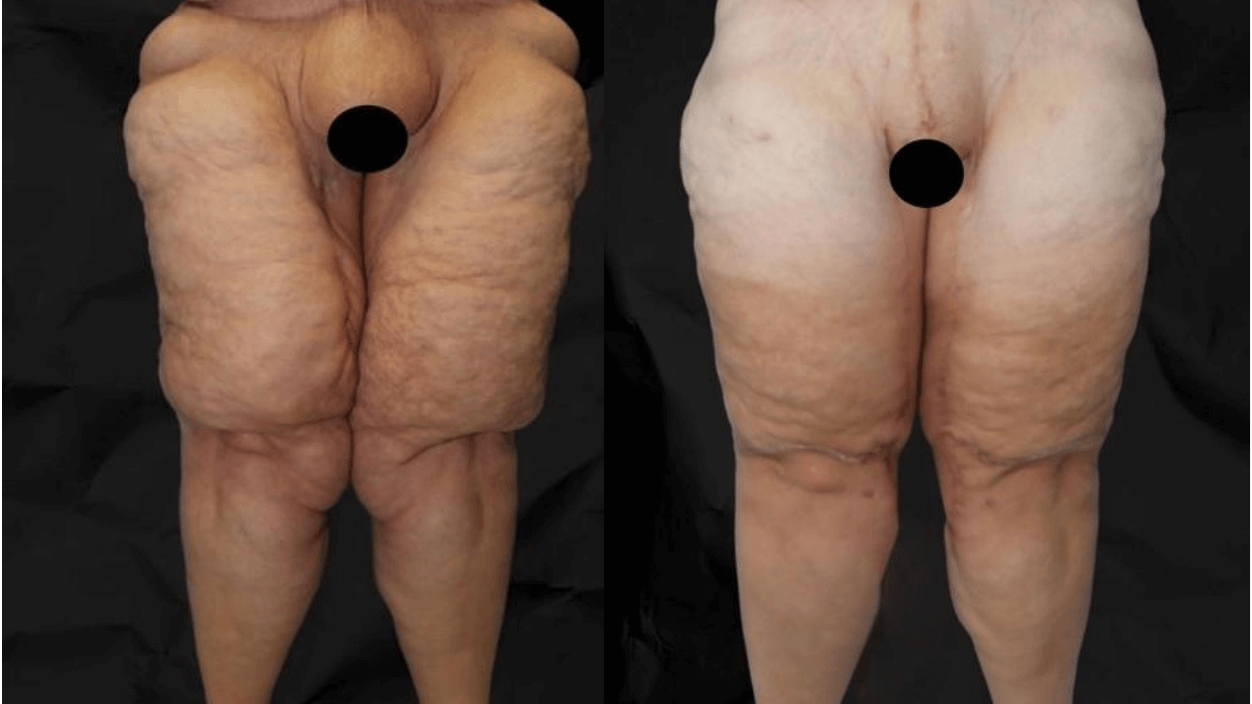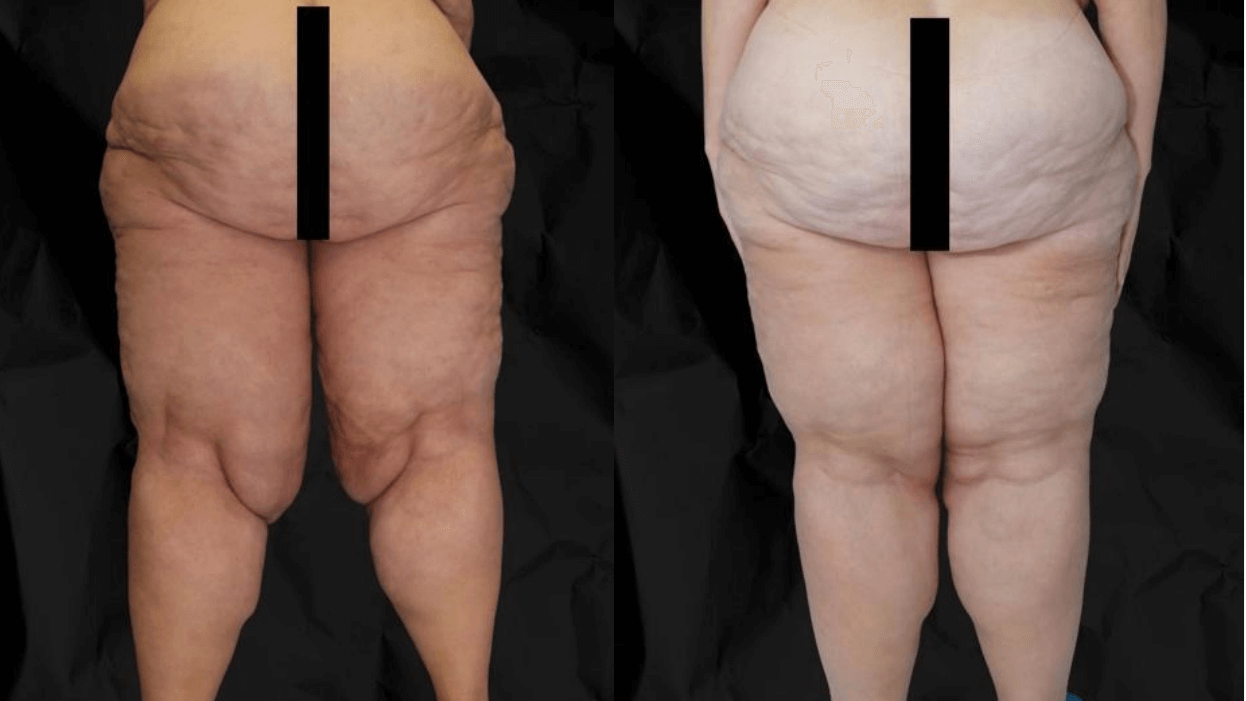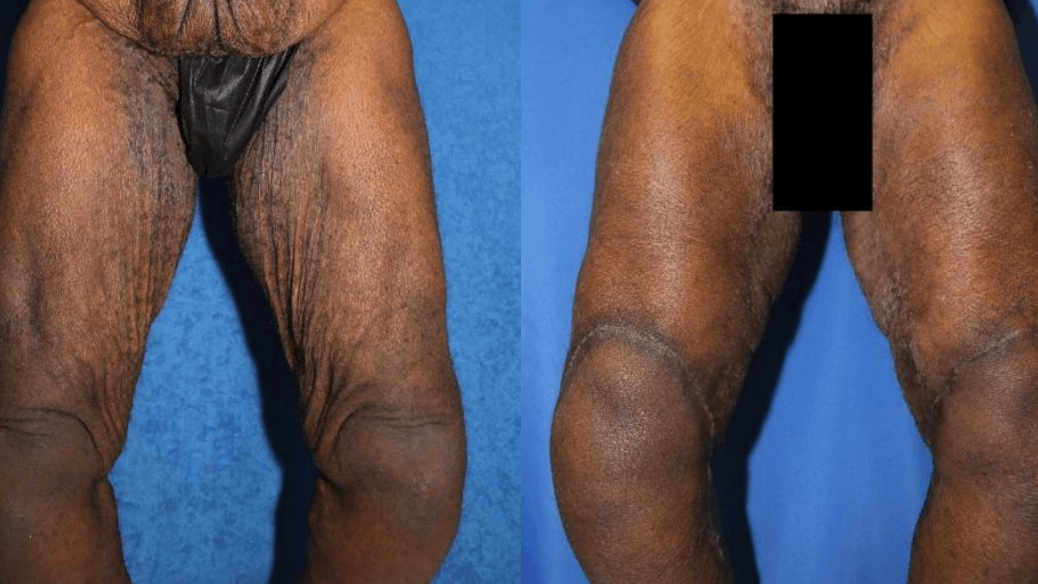Knee Reduction: Newly Invented Horseshoe Technique
3/21/2023
How to Permanently Remove Excess Skin and Fat from Around the Knees: The Newly Invented Horseshoe Technique
Many individuals have excess fat and skin around the knees after losing significant weight. This knee skin and fat excess can be unsightly and uncomfortable, leading to self-consciousness about one's appearance. Also, large knees can lead to difficulty in buying clothes that fit. Large knees can also make exercise difficult. Fortunately, a plastic surgery procedure can help remove the excess fat and skin around the knees to achieve a slimmer look. This blog will explain what knee reduction surgery is, how it works, and who may be a candidate for this type of plastic surgery.
What Is Knee Reduction Surgery?
Knee reduction surgery—also known as "horseshoe incision" or "upside-down U knee reduction"—is a plastic surgery procedure designed to remove excess skin and fat from around the knees. This procedure aims to reduce the circumference of the knees so that they are smaller and more aesthetically pleasing. It can also help reduce discomfort caused by excessive fat or loose skin hanging over the kneecap.
Who Is Eligible For a Knee Reduction Surgery?
Knee reduction surgery may be recommended for individuals who have lost significant weight but still have excess fat or loose skin hanging over their kneecaps, which cannot be reduced through diet or exercise alone. Knee reduction surgery can also be helpful for those with medical conditions such as lymphedema, which cause swelling in certain parts of the body, including around the knees. In addition, this type of plastic surgery after massive weight loss may be recommended if patients find their pants too tight due to enlarged kneecaps.
How Does Knee Reduction Surgery Work?
Knee reduction surgery is performed under general anesthesia. During this plastic surgery, an incision is made in a curve across the top of the patella or knee cap. The incision is shaped like a horseshoe or the upside-down letter "U." Through this incision, the knee's underlying skin and fatty tissues can be accessed. Excess knee fat and skin are removed through direct excision to create a slimmer kneecap area. Once all excess tissue has been removed, a drain is placed, and sutures are used to close the incision. Strict care is taken not to remove too much knee skin because if too much knee skin is removed, you cannot bend your knee. The knee reduction procedure takes about three to four hours to complete.
How Do I Take Care Of The Incision After A Knee Reduction Surgery?
Every plastic surgeon is different in the way they take incisions. Dr. Katzen prefers his patients apply Betadine to the incision twice daily. Betadine is preferred because Betadine is bactericidal—that means Betadine kills bacteria. After Betadine is applied, Dr. Katzen will have you place a bandage and then compression. Plan on incision care for about two to three weeks.
Is The Knee Reduction Surgery Procedure Require Hospitalization?
The horseshoe incision knee reduction procedure is outpatient and does not require hospitalization.
Does My Medical Insurance cover Knee Reduction Surgery?
Usually, knee reduction surgery is not covered by most medical insurance plans. Most medical insurance companies consider these knee problems cosmetic, even though large knees can interfere with ambulation, exercise, and other daily functions.
Are Drains Required For The Knee Reduction Surgery Procedure?
Yes, drains are required for the knee reduction surgery procedure. Usually, drains are removed about two to three weeks after the knee reduction procedure. The timing of drain removal depends on the amount of drainage, not necessarily the number of days after a procedure or how long the drains have been in place.
When Will All The Swelling Be Gone After A Knee Reduction Surgery?
You will have swelling, which will take six to eight weeks to resolve. If you have associated upper thigh or knee liposuction, drains may need to stay in place longer. The more active you are, the more your knees will remain swollen. Therefore, more activity leads to more swelling and, thus, a longer recovery.
When Can I Return To A Sitting Job After Knee Reduction Surgery?
Most of the strain on a horseshoe incision knee reduction occurs when the knee is bent. If you can keep your knees extended at your desk job, you can return to work two weeks after a knee reduction surgery.
When Can I Return To A Standing Job After Knee Reduction Surgery?
Standing exerts significant pressure on the lower extremities, especially the knee. Also, standing contributes to the lower leg and knee swelling. Therefore, if your employment requires significant time standing, plan to return to work about three to four weeks after a knee reduction procedure.
When Can I Start Exercising After A Knee Reduction Surgery?
Upper extremity exercises can be initiated one week after knee reduction surgery. However, lower extremity exercises must wait six to eight weeks until all the swelling is gone and the incision has healed well.
Will I Need Someone To Help Me Heal After Knee Reduction Surgery?
It would be best if someone could help you recover. The person helping you should be able to assist you to the bathroom and change your dressing. This person should also be able to drive you to all your appointments and be able to pick up any prescriptions. Also, your chosen assistant should be able to help you on and off the plane (if you flew to Los Angeles by plane). It is best to have someone assist you for about two weeks.
When Can I Climb Stairs After A Knee Reduction Surgery?
Climbing stairs requires a lot of knee bending. Climbing stairs also exerts significant pressure and strain on the incision. Therefore, it is critical to avoid stairs until your incision is sufficiently healed. Most knee reduction patients can return to going up and down stairs two to three weeks after surgery.
How Long Do I Need To Wear My Medical Grade Compression Garments?
One of the natural reactions to surgery is swelling. However, too much swelling can impede healing. Therefore, medical compression garments are used to reduce and minimize swelling. Most Knee Reduction Surgery patients have swelling for about six to eight weeks. Thus, it would be best if you planned on wearing your garments for six to eight weeks.
How Can I Minimize The Appearance Of The Scar After A Knee Reduction Surgery? Generally, most knee reduction surgery scars are healed in about six to eight weeks. Once the Knee Reduction Surgery scar has healed and there are no openings or areas of leakage, scar treatment can commence. Knee reduction surgery scar treatment can include silicone cream and silicone sheeting. If scars become thick, hypertrophic, or develop keloids, scars can be injected with steroids, 5 fluro-uracil, or Kenalog. Alternatively, scars can be treated with dermabrasion, micro-needling, or Morpheus 8.
If I Gain Weight, Will The Fat That Was Removed During The Knee Reduction Surgery Return To The Knee?
If you regain weight after a knee reduction surgery, the fat will not return to the knee. Of course, it is always best not to gain weight, but if you do, the fat accumulation will be equally distributed throughout your body.
&srotate=0)
&srotate=0)
Patient #1: This is a 36-year-old, 5'5", and 235 lbs. female. At her maximum weight, she weighed 495 pounds. She lost 260 pounds with diet, exercise, and vertical gastric sleeve. Additionally, she underwent thigh liposuction, vertical medial longitudinal thigh lift/reduction, and a horseshoe knee reduction with an incision over her kneecap. This patient healed very well; however, if you look closely at the first picture, you can see a scar over the top of her kneecap. Please note the significant overall improvement in her thighs, especially her knees. Individual results will vary.
&srotate=0)
Patient #2: This is a 46-year-old, 5'5", 220 lbs. male. His maximum was 419 pounds. He lost 204 pounds with diet exercise and gastric sleeve. He underwent thigh liposuction, vertical longitudinal medial thigh lift/reduction, and a horseshoe knee reduction. Please note the significant improvement in the shape of his knees. Individual results will vary.
&srotate=0)
&srotate=0)
&srotate=0)
Conclusion:
In conclusion, knee reduction surgery is an effective way for individuals who have lost significant amounts of weight to permanently remove excess fat and skin from around their knees to achieve a slimmer look. This plastic surgery requires an incision over the top of the knee cap to access underlying skin and fat.
Call Dr. Katzen TODAY at (310) 859-7770 to book your consultation if you are considering knee reduction surgery for excess knee skin and fat. Dr. Katzen conveniently has Beverly Hills, CA, and Dubai offices. In-person physical and virtual consultations can be scheduled discretely and privately. In addition, virtual consultations are available on FaceTime, Skype, Zoom, or WhatsApp for your convenience. So, call TODAY to start your journey for smaller knees.